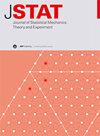伊辛模型上的贝特 M 层构造
IF 1.9
3区 物理与天体物理
Q2 MECHANICS
Journal of Statistical Mechanics: Theory and Experiment
Pub Date : 2024-06-25
DOI:10.1088/1742-5468/ad526e
引用次数: 0
摘要
在统计物理学中,研究二阶相变的标准方法之一是重正化群,它通常导致围绕相应全连接解的扩展。不幸的是,在无序模型中,一些重要的有限维二阶相变在相应的全连接模型中往往有质的不同或不存在:在这种情况下,标准扩展就失效了。最近,我们引入了一种新方法,即 M 层方法,它围绕不同的可溶性均场模型:贝特晶格模型进行扩展。这种新方法已被用于计算不同无序系统的上临界维度,如随机场伊辛模型或带场的自旋玻璃模型。如果我们想更进一步,围绕临界量的重正化构建一个扩展,就需要实际计算所有的数值因子。由于技术上的复杂性,下一步的计算尚未完成。在本文中,我们在有限维度上对没有淬火无序的铁磁伊辛模型进行了这一计算:我们表明,在 M 层方法内部的一环阶,我们恢复了连续四元场理论,并且能够确定耦合常数 g 和理论的其他参数,它们是模型的宏观和微观细节(如晶格间距、物理晶格维度和温度)的函数。这是基础性的一步,有助于将来将同样的技术应用于更复杂的系统,而标准的场论方法对这些系统是不可行的。本文章由计算机程序翻译,如有差异,请以英文原文为准。
Bethe M-layer construction on the Ising model
In statistical physics, one of the standard methods to study second order phase transitions is the renormalization group that usually leads to an expansion around the corresponding fully connected solution. Unfortunately, often in disordered models, some important finite dimensional second-order phase transitions are qualitatively different or absent in the corresponding fully connected model: in such cases the standard expansion fails. Recently, a new method, the M-layer one, has been introduced that performs an expansion around a different soluble mean field model: the Bethe lattice one. This new method has been already used to compute the upper critical dimension of different disordered systems such as the Random Field Ising model or the Spin glass model with field. If then one wants to go beyond and construct an expansion around to understand how critical quantities get renormalized, the actual computation of all the numerical factors is needed. This next step has still not been performed, being technically more involved. In this paper we perform this computation for the ferromagnetic Ising model without quenched disorder, in finite dimensions: we show that, at one-loop order inside the M-layer approach, we recover the continuum quartic field theory and we are able to identify the coupling constant g and the other parameters of the theory, as a function of macroscopic and microscopic details of the model such as the lattice spacing, the physical lattice dimension and the temperature. This is a fundamental step that will help in applying in the future the same techniques to more complicated systems, for which the standard field theoretical approach is impracticable.
求助全文
通过发布文献求助,成功后即可免费获取论文全文。
去求助
来源期刊
CiteScore
4.50
自引率
12.50%
发文量
210
审稿时长
1.0 months
期刊介绍:
JSTAT is targeted to a broad community interested in different aspects of statistical physics, which are roughly defined by the fields represented in the conferences called ''Statistical Physics''. Submissions from experimentalists working on all the topics which have some ''connection to statistical physics are also strongly encouraged.
The journal covers different topics which correspond to the following keyword sections.
1. Quantum statistical physics, condensed matter, integrable systems
Scientific Directors: Eduardo Fradkin and Giuseppe Mussardo
2. Classical statistical mechanics, equilibrium and non-equilibrium
Scientific Directors: David Mukamel, Matteo Marsili and Giuseppe Mussardo
3. Disordered systems, classical and quantum
Scientific Directors: Eduardo Fradkin and Riccardo Zecchina
4. Interdisciplinary statistical mechanics
Scientific Directors: Matteo Marsili and Riccardo Zecchina
5. Biological modelling and information
Scientific Directors: Matteo Marsili, William Bialek and Riccardo Zecchina

 求助内容:
求助内容: 应助结果提醒方式:
应助结果提醒方式:


